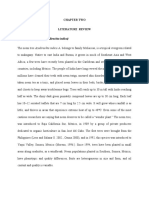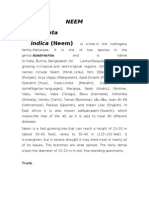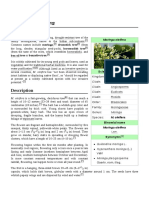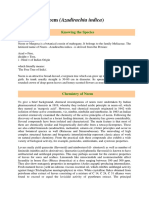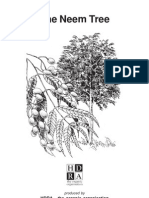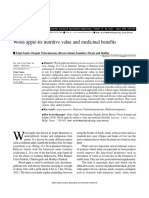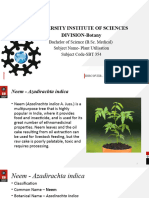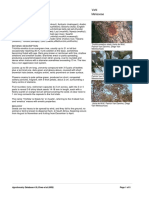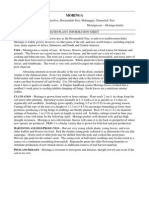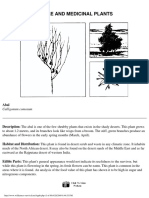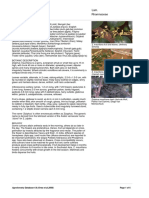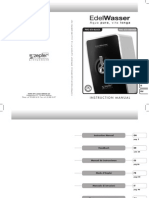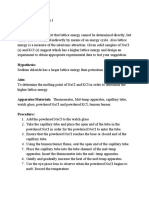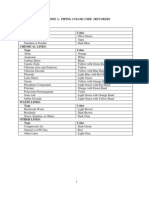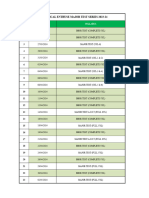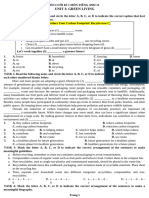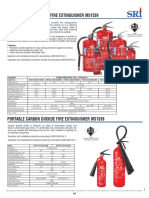NEEM Tree
NEEM Tree
Uploaded by
niceniviCopyright:
Available Formats
NEEM Tree
NEEM Tree
Uploaded by
niceniviOriginal Title
Copyright
Available Formats
Share this document
Did you find this document useful?
Is this content inappropriate?
Copyright:
Available Formats
NEEM Tree
NEEM Tree
Uploaded by
niceniviCopyright:
Available Formats
NEEM
Azadirachta indica, commonly known as neem, nimtree or Indian lilac and in Nigeria
called dogoyaro or dogonyaro, is a tree in the mahogany family Meliaceae. It is one of two species in the
genus Azadirachta, and is native to the Indian subcontinent and most of the countries in Africa. It is typically
grown in tropical and semi-tropical regions. Neem trees also grow on islands in southern Iran. Its fruits and
seeds are the source of neem oil.
Description-
Neem is a fast-growing tree that can reach a height of 15–20 meters (49–66 ft), and rarely 35–40 m (115–
131 ft). It is deciduous, shedding many of its leaves during the dry winter months. The branches are wide
and spreading. The dense crown is roundish and may reach a diameter of 20–25 m (66–82 ft). The neem tree
is similar in appearance to its relative, the chinaberry (Melia azedarach).[6]
White and fragrant flowers are arranged in more-or-less drooping axillary panicles which are up to 25 cm
(10 in) long. The inflorescences, which branch up to the third degree, bear from 250 to 300 flowers. An
individual flower is 5–6 mm (3⁄16–1⁄4 in) long and 8–11 mm (5⁄16–7⁄16 in) wide. Protandrous, bisexual
flowers and male flowers exist on the same individual tree.
The fruit is a smooth (glabrous), olive-like drupe which varies in shape from elongate oval to nearly
roundish, and when ripe is 14–28 mm (1⁄2–1+1⁄8 in) by 10–15 mm (3⁄8–5⁄8 in). The fruit skin (exocarp) is
thin, and the bitter-sweet pulp (mesocarp) is yellowish-white and very fibrous. The mesocarp is 3–5 mm
(1⁄8–1⁄4 in) thick. The white, hard inner shell (endocarp) of the fruit encloses one, rarely two, or three,
elongated seeds (kernels) having a brown seed coat.
Etymology
Neem (नीम) is a Hindi noun derived from Sanskrit Nimba (ननिंब).
Ecology
The neem tree is noted for its drought resistance. Normally it thrives in areas with sub-arid to sub-humid
conditions, with an annual rainfall of 400–1,200 mm (16–47 in). It can grow in regions with an annual rainfall
below 400 mm, but in such cases, it depends largely on ground water levels. Neem can grow in many
different types of soil, but it thrives best on well drained deep and sandy soils. It is a typical tropical to
subtropical tree and exists at annual mean temperatures of 21–32 °C (70–90 °F). It can tolerate high to very
high temperatures and does not tolerate temperature below 5 °C (41 °F). Neem is one of a very few shade-
giving trees that thrive in drought-prone areas e.g., the dry coastal, southern districts of India, and Pakistan.
An Environment Awareness Initiative by ABB India Limited (ELDS, Nashik)
The trees are not at all delicate about water quality and thrive on the merest trickle of water, whatever the
quality. In India and tropical countries where the Indian diaspora has reached, it is very common to see neem
trees used for shade lining streets, around temples, schools and other such public buildings or in most
people's back yards. In very dry areas the trees are planted on large tracts of land.
Phytochemicals
Neem fruit, seeds, leaves, stems, and bark contain diverse phytochemicals, some of which were first
discovered in azadirachta seed extracts, such as azadirachtin established in the 1960s as an
insect antifeedant, growth disruptor, and insecticide. The yield of azadirachtin from crushing 2 kg of seeds is
about 5 g. In addition to azadirachtin and related limonoids, the seed oil contains glycerides,
diverse polyphenols, nimbolide, triterpenes, and beta-sitosterol. The yellow, bitter oil has a garlic-like odor
and contains about 2% of limonoid compounds. The leaves contain quercetin, catechins, carotenes,
and vitamin C.
Traditional medicine
Products made from neem trees have been used in the traditional medicine of India for centuries, but there
is insufficient clinical evidence to indicate any benefits of using neem for medicinal purposes. In adults, no
specific doses have been established, and short-term use of neem appears to be safe, while long-term use
may harm the kidneys or liver; in small children, neem oil is toxic and can lead to death. Neem may also
cause miscarriages, infertility, and low blood sugar.
Pest and disease control
Neem is a key ingredient in non-pesticidal management (NPM), providing a natural alternative to synthetic
pesticides. Neem seeds are ground into powder that is soaked overnight in water and sprayed on the crop.
To be effective, it must be applied repeatedly, at least every ten days. Neem does not directly kill insects. It
acts as an anti-feed ant, repellent, and egg-laying deterrent and thus protects the crop from damage. The
insects starve and die within a few days. Neem also suppresses the subsequent hatching of their eggs. Neem-
based fertilizers have been effective against southern armyworm. Neem cake may be used as a fertilizer.
Neem oil has been shown to avert termite attack as an ecofriendly and economical agent.
Applications of neem oil in the preparation of polymeric resins have been documented in the recent reports.
The synthesis of various alkyd resins from neem oil is reported using a monoglyceride (MG) route and their
utilization for the preparation of PU coatings. The alkyds are prepared from reaction of conventional divalent
acid materials like phthalic and maleic anhydrides with MG of neem oil
Other uses
Tree: the neem tree is of great importance for its anti-desertification properties and possibly as a good
carbon dioxide sink. It is also used for maintaining soil fertility.
Fertilizer: neem extract is added to fertilizers (urea) as a nitrification inhibitor. Animal feed: neem leaves can
be occasionally used as forage for ruminants and rabbits. Teeth cleaning: neem has traditionally been used
as a type of teeth-cleaning twig. ESTs were identified by generation of subtractive hybridization libraries of
neem fruit, leaf, fruit mesocarp, and fruit endocarp by CSIR-CIMAP Lucknow
References –
➢ https://en.wikipedia.org/wiki/Azadirachta_indica
➢ https://www.healthline.com/nutrition/neem
An Environment Awareness Initiative by ABB India Limited (ELDS, Nashik)
You might also like
- Azadirachta Indica: (NEEM)Document23 pagesAzadirachta Indica: (NEEM)Michel Adam100% (1)
- Neem TreeDocument10 pagesNeem TreemandaremNo ratings yet
- Neem (Azadirachta Indica) A - JussDocument15 pagesNeem (Azadirachta Indica) A - JussgantichainuluNo ratings yet
- Chapter TwoDocument7 pagesChapter TwoStephen LonewolfNo ratings yet
- NEEMDocument10 pagesNEEMjabaduraithayalbabuNo ratings yet
- NEEMDocument6 pagesNEEMissacjebarajNo ratings yet
- The Neem Tree: Using The Different Parts of The Neem PlantDocument7 pagesThe Neem Tree: Using The Different Parts of The Neem PlantThomas Briggs100% (1)
- Moringa OleiferaDocument13 pagesMoringa OleiferaEmcee WaterNo ratings yet
- Zoology Project: Name: R. Sreemirinalini Registered No.: P1125Document28 pagesZoology Project: Name: R. Sreemirinalini Registered No.: P1125rajrudrapaaNo ratings yet
- NeemDocument8 pagesNeemwindow_7No ratings yet
- Neem PDFDocument10 pagesNeem PDFom prakashNo ratings yet
- Azadirachta Indica - Neem, A Versatile T - Carol StoneyDocument4 pagesAzadirachta Indica - Neem, A Versatile T - Carol Stoneydcollot8026No ratings yet
- Azadirachta Indica: Taxonomic ClassificationDocument11 pagesAzadirachta Indica: Taxonomic ClassificationJ-R SanchezNo ratings yet
- Neem Tree UsesDocument20 pagesNeem Tree UsesAsha_Shivaram100% (1)
- Chap 2Document7 pagesChap 2PriyankaNo ratings yet
- Aegle Marmelos: Rutaceae (L.) CorreaDocument5 pagesAegle Marmelos: Rutaceae (L.) CorreaSilmy AuliaNo ratings yet
- Azadirachta Indica LeavesDocument7 pagesAzadirachta Indica LeavesAaliyah Marie AbaoNo ratings yet
- RambutanDocument13 pagesRambutanIhsan1991 YusoffNo ratings yet
- Project Neem SanjayDocument40 pagesProject Neem Sanjaysinghjsanjay885No ratings yet
- Maharashtra Nature ParkDocument6 pagesMaharashtra Nature ParkMihir JoshiNo ratings yet
- Aegle Marmelos: Rutaceae (L.) CorreaDocument5 pagesAegle Marmelos: Rutaceae (L.) CorreavitazzoNo ratings yet
- Common NameDocument3 pagesCommon Namemonker lufferNo ratings yet
- Paper 3Document8 pagesPaper 3Angel CendañaNo ratings yet
- Moringa Specialty CropDocument12 pagesMoringa Specialty CropMohamed A Mahgoub100% (2)
- Moringa For Nutritional Security (Moringa Oleifera Lam.)Document4 pagesMoringa For Nutritional Security (Moringa Oleifera Lam.)Sandeep GunalanNo ratings yet
- Wood Apple ProcessingDocument5 pagesWood Apple ProcessingViji ThulasiramanNo ratings yet
- Medicinal PlantsDocument136 pagesMedicinal Plantsrushilkaushal9817774205No ratings yet
- Flemingia MacrophyllaDocument2 pagesFlemingia MacrophyllaTravisNo ratings yet
- Wilderness Survival - Edible and Medicinal Plants PDFDocument60 pagesWilderness Survival - Edible and Medicinal Plants PDFprivatnoNo ratings yet
- Meliaceae Fami, Ly by Naveen C A JoishiDocument8 pagesMeliaceae Fami, Ly by Naveen C A JoishiNAVEEN C. A. JOSHI Officials,No ratings yet
- Production Technology of GingerDocument14 pagesProduction Technology of GingerYanamandala VaishnaviNo ratings yet
- Trichilia Emetica: Meliaceae VahlDocument5 pagesTrichilia Emetica: Meliaceae VahlKaberia MberiaNo ratings yet
- Forestry Wasteland - NeemDocument8 pagesForestry Wasteland - NeemVipul SuranaNo ratings yet
- Available Online Through: International Journal of Pharmaceutical Archive-2 (3), 2013Document10 pagesAvailable Online Through: International Journal of Pharmaceutical Archive-2 (3), 2013Beladiena Citra Siregar100% (1)
- 30 VasilePRISACARIU, LucianSIMIONESCUDocument7 pages30 VasilePRISACARIU, LucianSIMIONESCUgeljay0638No ratings yet
- Cengkeh (Syzygium Aromaticum)Document5 pagesCengkeh (Syzygium Aromaticum)Odi Gita Nasution PradanaNo ratings yet
- Elaeis Guineensis: Arecaceae JacqDocument5 pagesElaeis Guineensis: Arecaceae JacqAnonymous m35iKgHNo ratings yet
- Chemical Eng. NeemDocument11 pagesChemical Eng. NeemCALEB ALHASSANNo ratings yet
- Organic Farming of Herbal Spices By-Shivanand M.RDocument50 pagesOrganic Farming of Herbal Spices By-Shivanand M.RShivanand RangapurNo ratings yet
- Tree Azadirachta Indica NeemDocument7 pagesTree Azadirachta Indica NeemBasavarajBusnurNo ratings yet
- ActaHortic. - MoringaDocument12 pagesActaHortic. - MoringaMarinaNo ratings yet
- Dacryodes Edulis: Burseraceae (G. Don.) H. J. LamDocument6 pagesDacryodes Edulis: Burseraceae (G. Don.) H. J. LamvitazzoNo ratings yet
- The Potential of Moringa Oleifera For Agricultural and Industrial UsesDocument20 pagesThe Potential of Moringa Oleifera For Agricultural and Industrial UsesMoringaidNo ratings yet
- Morinda CitrifoliaDocument5 pagesMorinda CitrifoliaFrancisco JoaldoNo ratings yet
- Olea Europaea: Family), A Traditional TreeDocument4 pagesOlea Europaea: Family), A Traditional TreetusharNo ratings yet
- Moringa Oleifera MoringaDocument2 pagesMoringa Oleifera Moringagemni7No ratings yet
- Wilderness SurvivalDocument60 pagesWilderness SurvivalJolly ManNo ratings yet
- Neem TreeDocument4 pagesNeem Treedorzky22No ratings yet
- Wild Ginger Production GuidelineDocument20 pagesWild Ginger Production GuidelinepvorsterNo ratings yet
- Terminalia ca-WPS OfficeDocument4 pagesTerminalia ca-WPS OfficePraise ChiamakaNo ratings yet
- Family Myrtaceae: TBB 2043 Biodiversity and Evolution of Monera, Fungi and Plantae Kumpulan A - Group 1Document62 pagesFamily Myrtaceae: TBB 2043 Biodiversity and Evolution of Monera, Fungi and Plantae Kumpulan A - Group 1Lihun WongNo ratings yet
- Ziziphus Mauritiana PDFDocument6 pagesZiziphus Mauritiana PDFRiky SetiawanNo ratings yet
- Ber Production Technology-ESWARDocument31 pagesBer Production Technology-ESWARDr.Eswara Reddy Siddareddy0% (1)
- Feronia Limonia: Rutaceae (L.) SwingleDocument5 pagesFeronia Limonia: Rutaceae (L.) SwinglevitazzoNo ratings yet
- EN 10028 PART 3: P275, P355 (N, NH) DICREST 5/10/15 Fine Grained Pressure Vessel Steel Adapted To Sour Service ConditionsDocument6 pagesEN 10028 PART 3: P275, P355 (N, NH) DICREST 5/10/15 Fine Grained Pressure Vessel Steel Adapted To Sour Service Conditionsjacob thangamNo ratings yet
- Laboratory Report 3.1 Organic Chemistry GRP 6Document4 pagesLaboratory Report 3.1 Organic Chemistry GRP 6Miles MonatoNo ratings yet
- AVK Water Supply BrochureDocument52 pagesAVK Water Supply BrochureHARSHANo ratings yet
- Chemistry TM Special GuideDocument42 pagesChemistry TM Special Guideseetharaman8341No ratings yet
- Utilisation of Biopolymer Combination As A Material For Making Gel Peel Off MaskDocument14 pagesUtilisation of Biopolymer Combination As A Material For Making Gel Peel Off Masktya chalifahNo ratings yet
- Withdrawing Medication From An AmpuleDocument7 pagesWithdrawing Medication From An AmpuleJisha JanardhanNo ratings yet
- COLLOIDSDocument15 pagesCOLLOIDSISRAEL VENIEGASNo ratings yet
- Edel - Wasser - PMD HC 019 11 ML PDFDocument68 pagesEdel - Wasser - PMD HC 019 11 ML PDFValerie EnglandNo ratings yet
- Exp. 7 Analysis of Milk For The Lipids Carbohydrates and ProteinsDocument6 pagesExp. 7 Analysis of Milk For The Lipids Carbohydrates and ProteinsEdchelNo ratings yet
- Hair DyeDocument17 pagesHair DyeChilaNo ratings yet
- Bright Cold Galvanising Spray: Technical DataDocument2 pagesBright Cold Galvanising Spray: Technical Datasivagnanam sNo ratings yet
- Plan and Design 1Document4 pagesPlan and Design 1Carlyn HarfordNo ratings yet
- Piping Color CodeDocument10 pagesPiping Color Codeعزت عبد المنعم100% (1)
- MSDS Gum Copal Magica AgroDocument6 pagesMSDS Gum Copal Magica AgroIrawan KhanNo ratings yet
- What Really Happens To The Plastic You Throw Away?: Emma Bryce - TED-EdDocument1 pageWhat Really Happens To The Plastic You Throw Away?: Emma Bryce - TED-EdJennefer Gudao AranillaNo ratings yet
- 22 Feb Goc 1 - OneDocument19 pages22 Feb Goc 1 - OneShreyaNo ratings yet
- 12 Principles of Green ChemistryDocument45 pages12 Principles of Green ChemistryJanjyoti OjahNo ratings yet
- DOWSIL™ 732 Multi-Purpose Sealant: Features & BenefitsDocument4 pagesDOWSIL™ 732 Multi-Purpose Sealant: Features & BenefitsRJ VIDEOSNo ratings yet
- Rolls-Royce Corporation, Indianapolis, Indiana Howmet Research Corporation, Whitehall, Michigan Cannon-Muskegon Corporation, Muskegon, Michigan ++NASA Glenn, Cleveland, OhioDocument9 pagesRolls-Royce Corporation, Indianapolis, Indiana Howmet Research Corporation, Whitehall, Michigan Cannon-Muskegon Corporation, Muskegon, Michigan ++NASA Glenn, Cleveland, OhioCaio Fazzioli TavaresNo ratings yet
- Coenzyme A FunctionsDocument5 pagesCoenzyme A FunctionsBenjamin IV LucasanNo ratings yet
- Medical Enthuse Major Test Plan 2023-24 (W.e.f. 09-03-24) ...Document2 pagesMedical Enthuse Major Test Plan 2023-24 (W.e.f. 09-03-24) ...Shatabdi DashNo ratings yet
- IUPAC ExerciseDocument27 pagesIUPAC ExerciseDhritismita Kalita100% (1)
- Sop For Precious MetalDocument5 pagesSop For Precious MetalChirag JainNo ratings yet
- Industrial Water Treatment Questions of The Day 1-2-20Document19 pagesIndustrial Water Treatment Questions of The Day 1-2-20AkashTripathiNo ratings yet
- Merchant ExportersDocument6 pagesMerchant ExportersSunny ManoharNo ratings yet
- PHYSIOLOGY Lecture Notes Chapter 1Document9 pagesPHYSIOLOGY Lecture Notes Chapter 1Aubrey Unique EvangelistaNo ratings yet
- ch-6 Bio Geeta Maam Notes pt1Document14 pagesch-6 Bio Geeta Maam Notes pt1Udyati DashNo ratings yet
- DRP001-OUF-STA-MTS-L-000-030-O1 - WMS Pickling and Passivation PDFDocument36 pagesDRP001-OUF-STA-MTS-L-000-030-O1 - WMS Pickling and Passivation PDFrodman823No ratings yet
- Ôn Cuối Kì 1 Môn Tiếng Anh 12Document9 pagesÔn Cuối Kì 1 Môn Tiếng Anh 12VincentNo ratings yet
- Portable Dry Powder Fire Extinguisher Ms1539: FeaturesDocument6 pagesPortable Dry Powder Fire Extinguisher Ms1539: FeaturesVash HeroNo ratings yet



